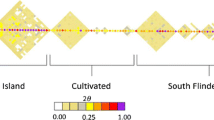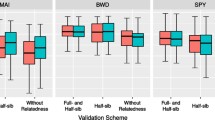Abstract
Estimations of genetic parameters of wood traits based on reduced sample populations are widely reported in the literature, but few investigations have considered the consequences of these small populations on the precision of parameter estimates. The purpose of this study was to determine an optimal strategy for sampling subgroups, by varying either the number of families or the number of individuals (trees) per family, and by verifying the accuracy of certain genetic parameters (across-trials analysis). To achieve this, simulations were conducted using random resampling without replacement (k = 1,000/pair of varying factors) on datasets containing 10-year total height of two coniferous species (Larix laricina and Picea mariana), as well as pilodyn measurements of wood density evaluated on a 26-year-old population of P. mariana. SAS® 9.2 Macro Language and Procedures were used to estimate confidence intervals of several genetic parameters with different reduced samplings. Simulation results show that reducing the number of trees per family per site had more impact on the magnitude and precision of genetic parameter estimates than reducing the number of families, especially for half-sib heritability and type B genetic correlations for height and wood density. A priori determination of an optimal subsampling strategy to evaluate the accuracy of genetic parameters should become common practice before assessing wood traits, in tree breeding studies or when planning juvenile retrospective progeny trials for forest tree species.


Similar content being viewed by others
References
Aastveit AH (1990) Use of bootstrapping for estimation of standard deviation and confidence intervals of genetic variance and covariance components. Biom J 32(5):515–527. doi:10.1002\bimj.4710320502
Apiolaza LA (2009) Very early selection for solid wood quality: screening for early winners. Ann For Sci 66(6):601–610. doi:10.1051/forest/2009047
Apiolaza LA (2011) Basic density of radiata pine in New Zealand: genetic and environmental factors. Tree Genet Genomes. doi:10.1007/s11295-011-0423-1
Apiolaza LA, Burdon RD, Garrick DJ (1999) Effect of univariate subsampling on the efficiency of bivariate parameter estimation and selection using half-sib progeny tests. For Genet 6(2):79–87
Blackburn D, Hamilton M, Harwood C, Innes T, Potts B, Williams D (2010) Stiffness and checking of Eucalyptus nitens sawn boards: genetic variation and potential for genetic improvement. Tree Genet Genomes. doi:10.1007/s11295-010-0289-7
Bouffier L, Rozenberg P, Raffin A, Kremer A (2008) Wood density variability in successive breeding populations of maritime pine. Can J For Res 38:2148–2158. doi:10.1139/X08-051
Chernick MR (1999) Bootstrap methods: a practioner’s guide. Wiley Series in Probability and Statistics: Applied Probability and Statistics Section. Wiley, New York
Cochran WG, Cox GM (1957) Experimental designs. Wiley, New York
Comstock RE, Moll RH (1963) Genotype-environment interactions. In: Hanson RE, Robinson HF (eds) Statistical genetics and plant breeding. NAS-NRC Pub. 982, Washington, DC, pp 169–194
Cornelius J (1994) Heritabilities and additive genetic coefficients of variation in forest trees. Can J For Res 24(2):372–379. doi:10.1139/x94-050
Cotterill PP, James JW (1984) Number of offspring and plot sizes required for progeny testing. Silvae Genetica 33(6):203–209
Dutkowski GW, Costa e Silva J, Gilmour AR, Wellendorf H, Aguiar A (2006) Spatial analysis enhances modelling of a wide variety of traits in forest genetic trials. Can J For Res 36(7):1851–1870. doi:10.1139/x06-059
El-Kassaby YA, Mansfield SD, Isik F, Stoehr M (2011) In situ wood quality assessment in Douglas-fir. Tree Genet Genomes 7:553–561. doi:10.1007/s11295-010-0355-1
Farmer JRRE, O’Reilly G, Shaotang D (1993) Genetic variation in juvenile growth of Tamarack (Larix laricina) in northwestern Ontario. Can J For Res 23(9):1852–1862
Fries A, Ericsson T (2006) Estimating genetic parameters for wood density of scots pine (Pinus sylvestris L.). Silvae Genetica 55(2):84–92
Fu Y-B, Yanchuck AD, Namkoong G (1999) Spatial patterns of tree height variations in a series of Douglas-fir progeny trials: implications for genetic testing. Can J For Res 29(6):714–723. doi:10.1139/x99-046
Gapare WJ, Ivkovic M, Baltunis BS, Matheson AC, Wu HX (2010) Genetic stability of wood density and diameter in Pinus radiata D. Don plantation estate across Australia. Tree Genet Genomes 6:113–125. doi:10.1007/s11295-009-0233-x
Gezan SA, Huber DA, White TL (2006) Post hoc blocking to improve heritability and precision of best linear unbiased genetic predictions. Can J For Res 36(9):2141–2147. doi:10.1139/x06-112
Greaves BL, Borralho NMG, Raymond CA, Farrington A (1996) Use of pilodyn for indirect selection of basic density in Eucalyptus nitens. Can J For Res 26(9):1643–1650. doi:10.1139/x26-185
Hodge GR, White TL (1992) Genetic parameter estimates for growth traits at different ages in slash pine and some implications for breeding. Silvae Genetica 41(4–5):252–262
Holland JB (2006) Estimating genotypic correlations and their standard errors using multivariate restricted maximum likelihood estimation with SAS Proc MIXED. Crop Sci 46:642–654. doi:10.2135/cropsci2005.0191
Huber DA, White TL, Hodge GR (1992) The efficiency of half-sib, half-diallel and circular mating designs in the estimation of genetic parameters in forestry: a simulation. Forest Sci 38(4):757–776
Isik F, Boos DD, Li B (2005) The distribution of genetic parameter estimates and confidence intervals from small disconnected diallels. Theor Appl Genet 110(7):1236–1243
Knapp SJ, Bridges WCJ, Yang M-H (1989) Nonparametric confidence interval estimators for heritability and expected selection response. Genetics 121(4):891–898
Knowles P, Furnier GR, Aleksiuk MA, Perry DJ (1987) Significant levels of self-fertilization in natural populations of tamarack. Can J Bot 65(6):1087–1091. doi:10.1139/b87-151
Krakowski J, Park YS, El-Kassaby YA (2005) Early testing of Douglas-fir: wood density and ring width. For Genet 12(2):99–105
Kruskal W, Wallis W (1952) Use of ranks in one criterion variance analysis. J Am Stat Assoc 47(260):583–621
Kruskal W, Wallis W (1953) Errata for Kruskal–Wallis (1952). J Am Stat Assoc 48:907–911
Kumar S, Dungey HS, Matheson AC (2006) Genetic parameters and strategies for genetic improvement of stiffness in radiata pine. Silvae Genetica 55(2):77–83
Lenz P, Cloutier A, MacKay J, Beaulieu J (2010) Genetic control of wood properties in Picea glauca—an analysis of trends with cambial age. Can J For Res 40(4):703–715. doi:10.1139/X10-014
Li P, Beaulieu J, Magnussen S, Gaétan D, Plourde A (1996) Application de méthodes d’analyse spatiale à deux tests génétiques de pin blanc. Rapport d’information edn. Ressources naturelles Canada, Service canadien des forêts, Centre de foresterie des Laurentides, Sainte-Foy, Qué
Li X, Huber DA, Powell GL, White TL, Peter GF (2007) Breeding for improved growth and juvenile corewood stiffness in slash pine. Can J For Res 37(10):1886–1893. doi:10.1139/X07-043
Littell RC, Milliken GA, Stroup WW, Wolfinger RD (1996) SAS system for mixed models. SAS Institute, Cary
Lynch M, Walsh B (1998) Genetics and analysis of quantitative traits. Sinauer Associates, Inc., Sunderland
Magnussen S (1993) Bias in genetic variance estimates due to spatial autocorrelation. Theor Appl Genet 86(2–3):349–355
Mead R (1990) The design of experiments: statistical principles for practical applications. Cambridge University Press, Cambridge
Namkoong G (1966) Inbreeding effects on estimation of genetic additive variance. Forest Sci 12(1):8–13
Namkoong G, Roberds JH (1974) Choosing mating designs to efficiently estimate genetic variance components for trees. Silvae Genetica 23(1–3):43–53
Osborne R, Paterson WSB (1952) On the sampling variance of heritability estimates derived from variance analyses. Proc R Soc Edinb Sect B 64:456–461
Pâques LE, Miller F, Rozenberg P (2010) Selection perspectives for genetic improvement of wood stiffness in hybrid larch (Larix x eurolepis Henry). Tree Genet Genomes 6:83–92. doi:10.1007/s11295-009-0239-0
Park YS, Fowler DP (1987) Genetic variances among clonally propagated populations of tamarack and the implications for clonal forestry. Can J For Res 17(10):1175–1180. doi:10.1139/x87-181
Patterson HD, Thompson R (1971) Recovery of interblock information when block sizes are unequal. Biometrika 58(3):545–554. doi:10.1093/biomet/58.3.545
Perron M (2008) A strategy for the second breeding cycle of Larix x marschlinsii in Québec, Canada including experiments to guide interspecific tree breeding programme. Silvae Genetica 57(4–5):282–291
Perry DJ, Bousquet J (2001) Genetic diversity and mating system of post-fire and post-harvest black spruce: an investigation using codominant sequence-tagged-site (STS) markers. Can J For Res 31(1):32–40. doi:10.1139/x00-137
Robertson A (1959) Experimental design in the evaluation of genetic parameters. Biometrics 15(2):219–226
Robitaille A, Saucier J-P (1998) Paysages régionaux du Québec méridional. Les publications du Québec, Sainte-Foy
Sae-Lim P, Komen H, Kause A (2010) Bias and precision of estimates of genotype-by-environment interaction: a simulation study. Aquaculture 310:66–73. doi:10.1016/j.aquaculture.2010.10.020
SAS (2009a) Base SAS® 9.2 Procedures Guide. SAS Institute Inc, Cary
SAS (2009b) SAS® 9.2 Macro Language: Reference. SAS Institute Inc, Cary
Shapiro S, Wilk M (1965) An analysis of variance test for normality (complete samples). Biometrika 52(3–4):591–611. doi:10.1093/biomet/52.3-4.591
Siegel S, Tukey J (1960) A nonparametric sum of ranks procedure for relative spread in unpaired samples. J Am Stat Assoc 55(291):429–445
Stackpole DJ, Vaillancourt RÉ, de Aguigar M, Potts BM (2010) Age trends in genetic parameters for growth and wood density in Eucalyptus globulus. Tree Genet Genomes 6:179–193. doi:10.1007/s11295-009-0239-4
Ukrainetz NK, Kang K-Y, Aitken SN, Stoehr M, Mansfield SD (2008) Heritability and phenotypic and genetic correlations of coastal douglas-fir (Pseudotsuga menziesii) wood quality traits. Can J For Res 38(6):1536–1546. doi:10.1139/X07-234
Wang T, Aitken SN, Rozenberg P, Carlson MR (1999) Selection for height growth and pilodyn pin penetration in lodgepole pine: effects on growth traits, wood properties, and their relationships. Can J For Res 29(4):434–445. doi:10.1139/x99-012
White TL, Adams WT, Neale DB (2007) Forest genetics. CABI, London
White TL, Hodge GR (1989) Forestry sciences. Predicting breeding values with applications in forest tree improvement, vol 33. Kluwer Academic Publishers, Dordrecht
Wright JW (1978) An analysis method to improve statistical efficiency of a randomized complete block design. Silvae Genetica 27:12–14
Yanchuck AD, Sanchez L (2011) Multivariate selection under adverse genetic correlations: impacts of population sizes and selection strategies on gains and coancestry in forest tree breeding. Tree Genet Genomes 110:1236–1243. doi:10.1007/s11295-011-0404-4
Zhang SY, Yu Q, Beaulieu J (2004) Genetic variation in veneer quality and its correlation to growth in white spruce. Can J For Res 34(6):1311–1318. doi:10.1139/X04-015
Acknowledgments
We acknowledge all “Ministère des Ressources Naturelles et de la Faune” of Québec (MRNF-Q) staff that participated in collecting the data, and particularly Mr. Gaston Lapointe and Gaétan Numainville who, for years, led all technical aspects of tamarack and black spruce Québec tree improvement programs; Lise Charette who collaborated with J.D. to write the spatial autocorrelation SAS code program; Dr. Patrick Lenz and two anonymous reviewers for valuable comments; as well as Denise Tousignant for the English revision of the submitted manuscript. This study was conducted with the financial support of two MRNF-Q projects on genetics of wood properties: one on tamarack and one on black spruce (projects number 112310080 and 112310074). Finally, tamarack and black spruce breeding programs would not be possible without the long-term financial support of MRNF-Q.
Author information
Authors and Affiliations
Corresponding author
Additional information
Communicated by J. Beaulieu
Electronic supplementary material
Below is the link to the electronic supplementary material.
ESM 1
(DOC 73 kb)
ESM 2
(DOC 91 kb)
ESM 3
(DOC 71 kb)
Appendix A
(PDF 144 kb)
Rights and permissions
About this article
Cite this article
Perron, M., DeBlois, J. & Desponts, M. Use of resampling to assess optimal subgroup composition for estimating genetic parameters from progeny trials. Tree Genetics & Genomes 9, 129–143 (2013). https://doi.org/10.1007/s11295-012-0540-5
Received:
Revised:
Accepted:
Published:
Issue Date:
DOI: https://doi.org/10.1007/s11295-012-0540-5




